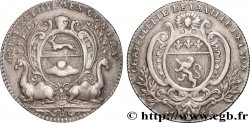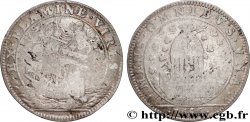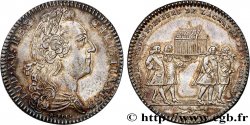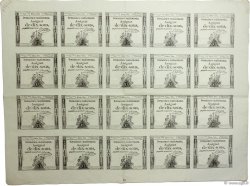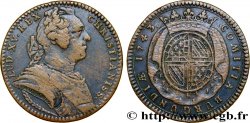fjt_128042 - CORPORATIONS Jeton Ar 28, corroyeurs 1755
Not available.
Item sold on our e-shop
Price : 120.00 €
Item sold on our e-shop
Price : 120.00 €
Type : Jeton Ar 28, corroyeurs
Date: 1755
Metal : silver
Diameter : 28,5 mm
Orientation dies : 6 h.
Weight : 7,26 g.
Coments on the condition:
Exemplaire splendide avec très peu de patine. Deux rayures fines dans le champ au droit, devant le front du roi
Catalogue references :
Obverse
Obverse legend : LOUIS XVI ROI DE FRANCE ET DE NAVARRE..
Obverse description : Buste à gauche de Louis XVI, signé J. P. DROZ. F., type Guéant Prieur 732A.
Reverse
Reverse legend : MES CORROYEURS PORTEURS DE LA CHASSE DE ST MERRY ; À L'EXERGUE : 1755.
Reverse description : Quatre bourgeois portant la châsse de Saint Merry, à l'exergue : instruments de corroyage.
Commentary
Ce jeton manque à Feuardent. Il est à placer avec le F.5075 mais en diffère largement par l’avers.
Il ne date pas de 1755 mais date plutôt des années 1780. Les cuirs tannés forment deux grandes catégories : celle des cuirs forts et celle des cuirs à œuvre ou molleterie. Les premiers destinés à la fabrication des objets qui demandent une certaine rigidité, tels, par exemple, que les semelles des chaussures ; les seconds servant, au contraire à la confection des empeignes de souliers, des tiges de bottes et, en général, de tous les ouvrages de cordonnerie, de sellerie, de bourrellerie, etc.. qui réclament une grande souplesse. Les cuirs forts sont employés aussitôt après le tannage, tandis que les cuirs à œuvre doivent être soumis, avant d'être livrés au commerce, à des manipulations plus ou moins compliquées, ayant pour objet de les approprier aux usages spéciaux qu'on veut en faire. C'est l'exécution de ces manipulations qui constitue l'art du corroyeur.
This token is missing from Feuardent. It should be placed with F.5075 but differs significantly in the obverse. It does not date from 1755 but rather from the 1780s. Tanned leathers form two broad categories: strong leathers and leathers for working or molleterie. The former are intended for the manufacture of objects that require a certain rigidity, such as, for example, shoe soles; the latter are used, on the contrary, for the manufacture of shoe uppers, boot uppers and, in general, all shoemaking, saddlery, harness making, etc., which require great flexibility. Strong leathers are used immediately after tanning, while working leathers must be subjected, before being delivered to the trade, to more or less complicated manipulations, the purpose of which is to adapt them to the special uses to which they are to be put. It is the execution of these manipulations that constitutes the art of the tanner
Il ne date pas de 1755 mais date plutôt des années 1780. Les cuirs tannés forment deux grandes catégories : celle des cuirs forts et celle des cuirs à œuvre ou molleterie. Les premiers destinés à la fabrication des objets qui demandent une certaine rigidité, tels, par exemple, que les semelles des chaussures ; les seconds servant, au contraire à la confection des empeignes de souliers, des tiges de bottes et, en général, de tous les ouvrages de cordonnerie, de sellerie, de bourrellerie, etc.. qui réclament une grande souplesse. Les cuirs forts sont employés aussitôt après le tannage, tandis que les cuirs à œuvre doivent être soumis, avant d'être livrés au commerce, à des manipulations plus ou moins compliquées, ayant pour objet de les approprier aux usages spéciaux qu'on veut en faire. C'est l'exécution de ces manipulations qui constitue l'art du corroyeur.
This token is missing from Feuardent. It should be placed with F.5075 but differs significantly in the obverse. It does not date from 1755 but rather from the 1780s. Tanned leathers form two broad categories: strong leathers and leathers for working or molleterie. The former are intended for the manufacture of objects that require a certain rigidity, such as, for example, shoe soles; the latter are used, on the contrary, for the manufacture of shoe uppers, boot uppers and, in general, all shoemaking, saddlery, harness making, etc., which require great flexibility. Strong leathers are used immediately after tanning, while working leathers must be subjected, before being delivered to the trade, to more or less complicated manipulations, the purpose of which is to adapt them to the special uses to which they are to be put. It is the execution of these manipulations that constitutes the art of the tanner








 Report a mistake
Report a mistake Print the page
Print the page Share my selection
Share my selection Ask a question
Ask a question Consign / sell
Consign / sell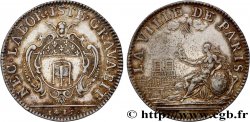
 Full data
Full data